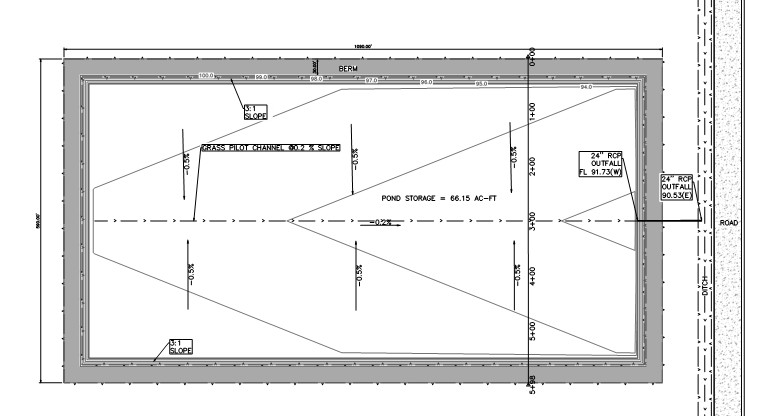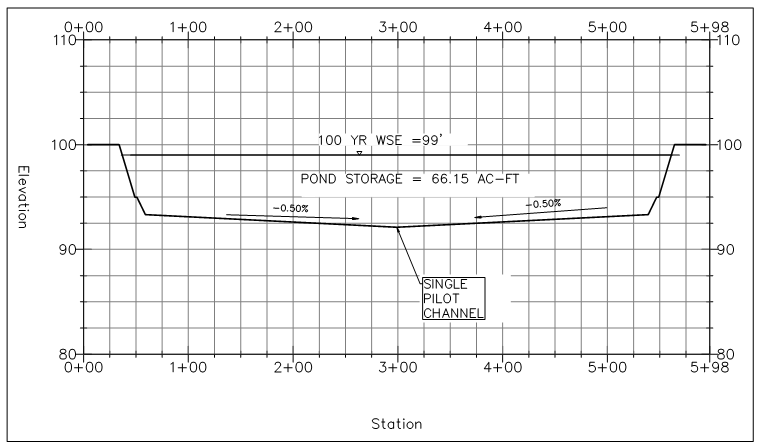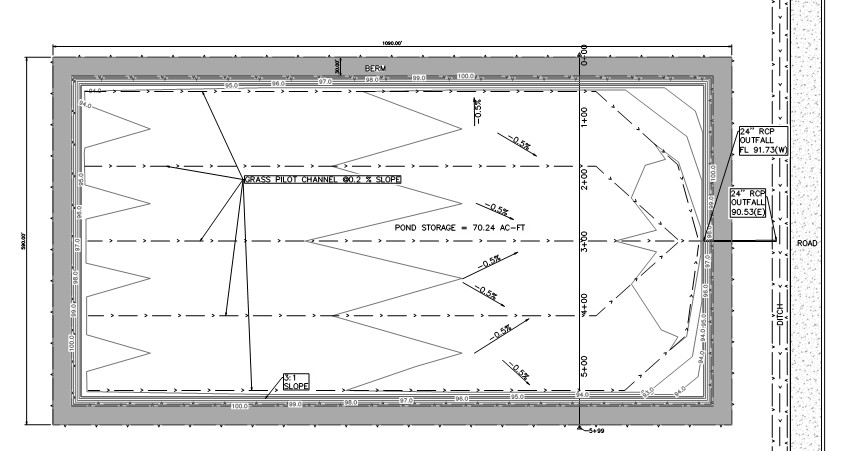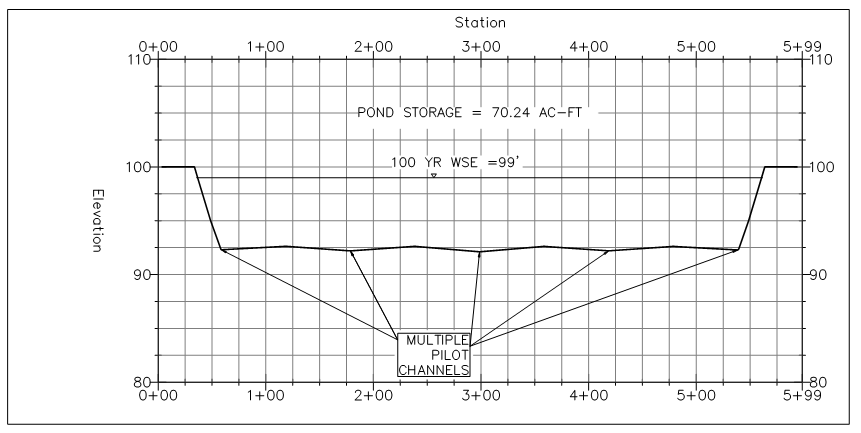Ijraset Journal For Research in Applied Science and Engineering Technology
- Home / Ijraset
- On This Page
- Abstract
- Introduction
- Conclusion
- References
- Copyright
Multi-Channel Stormwater Ponds: A Sustainable Approach to Urban Flood Resilience
Authors: Akshay Dumbre, Prathamesh Bhoir
DOI Link: https://doi.org/10.22214/ijraset.2024.64146
Certificate: View Certificate
Abstract
Flood-prone cities depend on stormwater ponds, but current designs with single, shallow channels limit storage. This paper proposes a new approach: using multiple channels to create smaller sections on the pond floor. Modeling shows this significantly increases storage for floods without needing a bigger pond. It also improves water flow and reduces stagnant areas. Finally, the paper explores practicalities for building these ponds, making them a valuable tool for better urban water management without needing more land or changing the pond’s height. These multi-channel ponds are particularly beneficial for frequent smaller storms by distributing water flow, reducing its speed, and allowing more time for sediment to settle, leading to improved water quality. Sustainable solutions are essential for safeguarding the future. In this research, sustainability plays a pivotal role, as the multi-channel stormwater pond design provides an innovative approach to improving flood management without the need for extra land or resources, thus supporting the goals of sustainable urban development.
Introduction
I. INTRODUCTION
Urban areas are increasingly vulnerable to the detrimental effects of climate change, particularly in the form of more frequent and intense flooding events. Additionally, climate change affects stormwater and urban runoff [7]. Areas with high impervious surface areas experience increased runoff due to the inability of rainwater to infiltrate the ground [1]. The conversion of natural landscapes into built environments is known to alter the hydrological dynamics of a region, often leading to accelerated runoff and reduced infiltration rates [2]. Flooding, with its environmental impact, represents a naturally destructive process that typically results in severe damage [3]. The increasing frequency and severity of floods demand a more comprehensive approach to understanding and mitigating flood risk [4]. Traditional stormwater management systems, such as single- channel stormwater detention ponds, have historically been the primary defense against these threats. However, these conventional designs often prove inadequate in the face of escalating precipitation patterns. The ongoing challenge of stormwater management necessitates innovative and sustain- able approaches. A continuous need exists for sustainable methods to mitigate urban flooding. The majority of these ponds were designed and constructed using the traditional single-channel approach, which, while effective in certain scenarios, frequently exhibits limitations. As urbanization con- tinues to expand, the demand for more efficient, space-saving, and sustainable stormwater management solutions becomes increasingly urgent. Detention ponds, in particular, tend to occupy significant amounts of land, limiting the available space for buildings, parking, and other development. This can pose economic challenges for developers who aim to maximize the usable area of their properties. To address these challenges, this paper proposes a novel multi-channel stormwater pond design. By incorporating mul- tiple interconnected channels within a single pond, this in- novative approach aims to optimize stormwater detention, enhance storage capacity, and improve the efficient use of land, making projects more economically viable. Additionally, for existing structures where detention ponds were built based on historical rainfall data, this design offers a potential solution to accommodate increased rainfall frequencies and intensities over the years without requiring significant alterations to existing infrastructure or additional land. Through a combination of hydrological modeling and prac- tical considerations, this research explores the feasibility and benefits of multi-channel stormwater ponds. The study’s find- ings suggest that these designs could play a pivotal role in improving the resilience of urban environments in the face of climate change. By providing municipalities with a viable alternative to traditional stormwater management systems, multi-channel ponds offer a promising avenue for enhancing urban flood protection and sustainability.
II. LITERATURE REVIEW
Urban areas, increasingly vulnerable to climate change- induced flooding, have historically relied primarily on stormwater ponds for flood control. These traditional ponds, often characterized by single, shallow channels, have proven effective in certain scenarios but face limitations in managing the escalating frequency and intensity of extreme weather events. Inadequate storage capacity, stagnant water zones, and suboptimal sedimentation processes are common challenges associated with these conventional designs. Numerous studies have underscored the need for innovative stormwater man- agement solutions that can effectively mitigate flood risks without expanding the physical footprint of these infrastructure elements.
Recent advancements in hydrological modeling and urban water management have spurred interest in rethinking the design of stormwater ponds. In this paper, we have explored the potential of multi-channel systems to enhance storage capacity and overall pond performance. The findings from our studies suggest that multi-channel stormwater ponds could offer a more resilient and effective solution for urban flood mitigation, especially in densely populated areas prone to flooding by optimizing pond storage.
While the theoretical benefits of multi-channel stormwater ponds are promising, practical considerations for their imple- mentation have received less attention in the literature. Key challenges include the construction feasibility, maintenance re- quirements, and cost-effectiveness of these systems compared to conventional designs. Moreover, while modeling studies provide valuable insights, empirical research is essential to validate the performance of multi-channel ponds in real-world settings. This paper aims to address these gaps by proposing a novel multi-channel stormwater pond design and exploring the practical aspects of its construction and maintenance. By integrating theoretical modeling with practical considerations, this research contributes to the development of more effective and sustainable stormwater management solutions that can be implemented in urban areas without requiring additional land or significant changes to pond elevations.
III. METHODOLOGY
To determine the effectiveness of different stormwater pond designs in enhancing storage capacity, we conducted a com- parative analysis using Civil 3D software. Two distinct pond models were developed: a traditional single-channel pond and a novel multi-channel pond. The primary objective was to evaluate whether the multi-channel design could increase storage capacity without expanding the pond’s footprint.

Fig. 1: Detention Pond with Single Pilot Channel - Plan View
The single-channel pond, a common design in stormwater management, served as the baseline for comparison. The multi-channel pond introduced a new concept, aiming to improve water distribution and storage efficiency through mul- tiple pilot channels. Both models were designed with identical highbank elevations and pilot channel slopes to ensure a fair comparison. The side slopes of the ponds were also standardized to maintain consistency. To ensure that any differences in storage capacity were solely attributable to the number of channels, we maintained a consistent outfall flowline elevation for both models. This allowed us to isolate the impact of the channel design on stormwater storage. To mitigate erosion risks associated with the gentle slopes of the pilot channels, we proposed the use of Vegetated geogrids and seeding. These reinforcement materials can help stabilize the soil and prevent erosion, ensuring the long-term integrity of the channels, particularly during heavy rain events.

Fig. 2: Detention Pond with Single Pilot Channel - Profile View

Fig. 3: Detention Pond with Multiple Pilot Channel - Plan View

Fig. 4: Detention Pond with Multiple Pilot Channel - Profile View
In conclusion, our methodology involved a rigorous com- parison of two stormwater pond designs. By modeling both a traditional single-channel pond and an innovative multi- channel pond, we were able to demonstrate the practical benefits of the multi-channel design in enhancing stormwater storage capacity. This approach offers a promising solution for urban flood management by maximizing the efficiency of stormwater ponds without requiring additional land or significant alterations to existing infrastructure.
IV. RESULTS
Our study has conclusively demonstrated that multi-channel stormwater pond designs significantly outpace single-channel designs in terms of storage capacity. The pond model with a single pilot channel achieved a storage capacity of 66.15 acre-feet, while the model incorporating multiple pilot chan- nels significantly boosted this capacity to 70.24 acre-feet. This represents a remarkable increase of approximately 6.2 percent in storage capacity, achieved without encroaching on additional land. This enhanced storage capability is particu- larly advantageous for managing frequent, smaller storms. By dispersing water more effectively and reducing flow velocity, multi-channel ponds mitigate the risk of flooding and erosion. One of the most compelling findings of our research was the minimal additional construction costs associated with the multi-channel design. The design modifications required only subtle alterations to the pond’s internal layout, resulting in negligible increases in material and labor costs. This cost- effectiveness is a major advantage, making multi-channel ponds an attractive option for urban areas seeking to improve their stormwater management systems without incurring substantial financial burdens.
Moreover, the multi-channel design offers long-term sus- tainability benefits. By maximizing the use of existing space and resources, this approach aligns with sustainable urban development principles. The increased storage capacity with- out expanding the pond’s footprint or height provides en- hanced flood protection while minimizing environmental im- pact. In conclusion, our study provides compelling evidence for the effectiveness, cost-efficiency, and sustainability of multi-channel stormwater pond designs. By incorporating mul- tiple pilot channels, municipalities can significantly increase their stormwater storage capacity, improve water quality, and reduce the risk of flooding. This innovative design offers a practical and sustainable solution for addressing the challenges of urban stormwater management, providing a clear path for- ward for communities seeking to enhance their environmental resilience.
V. DISCUSSION
The findings of this study are particularly significant as they underscore the potential of multi-channel stormwater pond designs to enhance urban resilience. Our results demonstrate a substantial increase in storage capacity (approximately 6.2 percent) without requiring additional land or significant con- struction costs. By optimizing existing space and resources, multi-channel designs offer a practical and sustainable solution for urban areas, particularly those prone to flooding. The implementation of such designs could lead to more resilient ur- ban infrastructure, capable of better handling extreme weather events.
While the study presents promising outcomes, it’s essential to note that the results are primarily based on modeling.
To validate these findings further, real-world applications are necessary. Future research should focus on the long-term per- formance and maintenance implications of multi-channel sys- tems in diverse environmental conditions. Moreover, while our study indicates minimal additional construction costs, more comprehensive cost-benefit analyses across various scenarios would provide a clearer understanding of the financial viability of such designs. Factors such as the specific characteristics of the site, local regulations, and maintenance requirements should be considered in future evaluations.
Conclusion
Storm-water related events are becoming more frequent and intense as one of the consequences of climatic changes across the globe, negatively impacting buildings and urban infrastructure, both financially and socially [9]. Sustainable stormwater management practices are essential for overcoming various environmental challenges and promoting community sustainability and resilience [6]. Stormwater management is a key issue in line with global problems of urbanization and climate change [8]. The impact of heavy storms can be reduced by improving the infrastructure and providing a stormwater network that can efficiently drain the rain [5]. The study addressed the pressing issue of limited storage capacity in conventional stormwater pond designs, introducing a cost-effective and sustainable solution that aligns with the growing need for resilient urban infrastructure. By optimizing existing space and resources, multi-channel designs offer a practical improvement over traditional methods, particularly in cities where land availability is limited. The findings of our research suggest that municipalities and urban planners could adopt multi-channel designs to enhance flood protection while maintaining existing spatial constraints. This approach can contribute to more resilient urban environ- ments, better equipped to withstand the increasing frequency and intensity of extreme weather events. While our results are promising, it’s important to note that they are based on mod- eling. Further empirical research is necessary to confirm the applicability of multi-channel designs in real-world settings. Future studies should focus on the long-term performance, maintenance needs, and cost-effectiveness of these designs in diverse environmental conditions to fully realize their potential benefits.
References
[1] Lee, S.; Choi, Y.; Ji, J.; Lee, E.; Yi, S.; Yi, J. Flood Vulnerability Assessment of an Urban Area: A Case Study in Seoul, South Korea. Water 2023, 15, 1979. https://doi.org/10.3390/w15111979 [2] Akshay V.Dumbre , (2024 ) ” Enhancing Resilience: Strategies for Flood Mitigation in Mumbai’s Urban Expansion through Storm Detention ” , International Journal of Advances in Science, Engineering and Technology(IJASEAT) , pp. 107-110, Volume-12,Issue-1 [3] Ghobadi, M., Ahmadipari, M. Enhancing Flood Susceptibility Modeling: a Hybrid Deep Neural Network with Statistical Learning Algorithms for Predicting Flood Prone Areas. Water Resour Manage 38, 2687–2710 (2024). https://doi.org/10.1007/s11269-024-03770-7 [4] Dey, H., Shao, W., Haque, M. et al. Enhancing Flood Risk Anal- ysis in Harris County: Integrating Flood Susceptibility and So- cial Vulnerability Mapping. J geovis spat anal 8, 19 (2024). https://doi.org/10.1007/s41651-024-00181-5 [5] Hamdan, M. (2024). Case Study: Stormwater network construction. In Engineering and science hub journal (Vol. 1, Number 04). Engineering and science hub journal. https://doi.org/10.5281/zenodo.11115311 [6] Karamoutsou, L.; Veliou, E.; Kvernberg, E.B.; Psilovikos, A. Urban Stormwater Management: A Sustainable Approach. Water 2024, 16, 2089. https://doi.org/10.3390/w16152089 [7] Liana Prudencio and Sarah E Null 2018 Environ. Res. Lett. 13 033002 [8] Zhang, Y.; Zhao, W.; Chen, X.; Jun, C.; Hao, J.; Tang, X.; Zhai, J. Assessment on the Effectiveness of Urban Stormwater Management. Water 2021, 13, 4. https://doi.org/10.3390/w13010004 [8] Jandaghian, Z.; Zhu, Y.; Saragosa, J.; Doshi, H.; Baskaran, B. Low-Sloped Rooftop Storm-Water Detention Assembly to Mitigate Urban Flooding. Buildings 2023, 13, 8. https://doi.org/10.3390/buildings13010008
Copyright
Copyright © 2024 Akshay Dumbre, Prathamesh Bhoir. This is an open access article distributed under the Creative Commons Attribution License, which permits unrestricted use, distribution, and reproduction in any medium, provided the original work is properly cited.

Download Paper
Paper Id : IJRASET64146
Publish Date : 2024-09-02
ISSN : 2321-9653
Publisher Name : IJRASET
DOI Link : Click Here
 Submit Paper Online
Submit Paper Online

